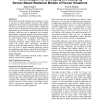CHI
2007
ACM
14 years 12 months ago
2007
ACM
It is well-established finding that people find maps easier to use when they are aligned so that "up" on the map corresponds to the user's forward direction. With m...
CHI
2007
ACM
14 years 12 months ago
2007
ACM
Sensor-based statistical models promise to support a variety of advances in human-computer interaction, but building applications that use them is currently difficult and potentia...
CHI
2007
ACM
14 years 12 months ago
2007
ACM
Video surrogates are meant to help people quickly make sense of the content of a video before downloading or seeking more detailed information. In this paper we present the result...
CHI
2007
ACM
14 years 12 months ago
2007
ACM
Massively multiplayer online games (MMOGs) currently represent the most widely used type of social 3D virtual worlds with millions of users worldwide. Although MMOGs take face-to-...
CHI
2007
ACM
14 years 12 months ago
2007
ACM
The paper describes an approach to modeling the strategic variations in performing secondary tasks while driving. In contrast to previous efforts that are based on simulation of a...
CHI
2007
ACM
14 years 12 months ago
2007
ACM
This paper presents a quantitative human performance model of making single-stroke pen gestures within certain error constraints in terms of production time. Computed from the pro...
CHI
2007
ACM
14 years 12 months ago
2007
ACM
Recent world-wide crisis events have drawn new attention to the role information communication technology (ICT) can play in warning and response activities. Drawing on disaster so...
CHI
2007
ACM
14 years 12 months ago
2007
ACM
We present an empirical study of teams that revealed the amount of extraneous individual work needed to enable collaboration: finding references to other people, finding files to ...
CHI
2007
ACM
14 years 12 months ago
2007
ACM
This research examines a design guideline that aims to increase the positive perception of interruptions. The guideline advocates matching the amount of attention attracted by an ...
CHI
2007
ACM
14 years 12 months ago
2007
ACM
The design of applications using mobile devices needs a different quality assessment than those known for desktop applications. Of the many aspects that have to be taken into acco...




